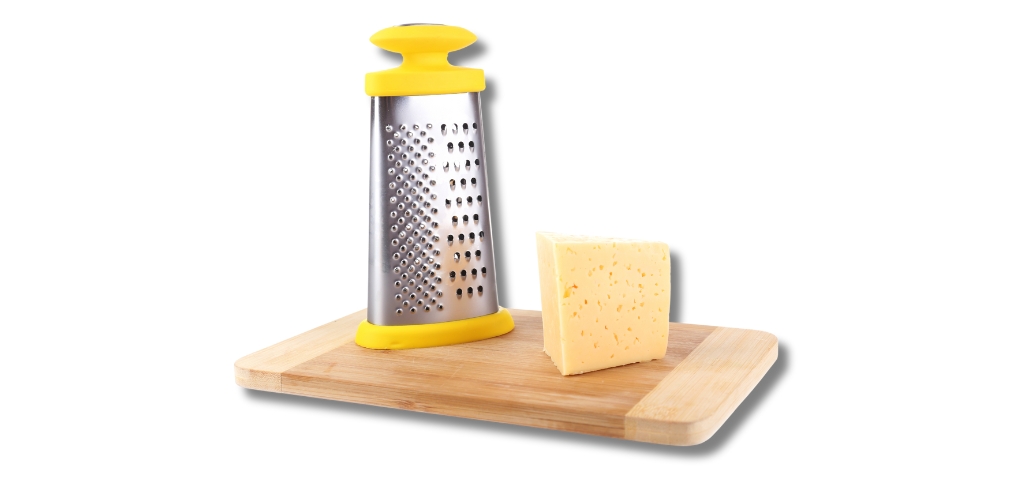Wondering how to wash a cheese grater? Don’t worry. For every amateur chef and kitchen enthusiast, learning the technique of cleaning your cheese grater will alter your life. Not only does a clean grater guarantee best results, it also preserves the flavor and freshness of your grated cheeses. In this comprehensive guide, we’ll walk you through the step-by-step process of how to wash a cheese grater, so you can enjoy the benefits of a hygienic and efficient kitchen tool.
Step-by-Step Guide for How to Wash a Cheese Grater
Before we get started, let me just say that the best approach to clean your cheese grater will depend on the kind you have. In general, there are three common types of cheese graters: box graters, rotary graters, and microplane/zester graters. Each has its unique design and features, which may require slightly different cleaning methods.
Step 1: Prepare Your Cleaning Supplies
To efficiently clean your cheese grater, you’ll need the following supplies:
- Dish soap or detergent
- Warm water
- Sponge/brush with soft bristles
- Soft cloth/towel for drying
Step 2: Remove Any Residue or Debris
Before washing your grater, it’s important to remove any excess cheese or food particles. You can do this by running a spatula or the back of a kitchen knife over the grater’s surface to loosen and remove any residue. This will help keep your sink from clogging and make cleaning easier.
Step 3: Soak the Grater
Pour some warm water into a big basin or sink, then stir in a few drops of dish soap. After submerging the greater pieces in the soapy water, leave them there for at least ten minutes. Any tough food particles will become more pliable as a result, making removal simpler.
Step 4: Scrub Away Food Residue
Using a sponge or soft-bristled brush, gently scrub the grater in a back-and-forth motion. Pay extra attention to the holes and edges of the grater, as these areas are prone to collecting food residue. For tougher stains or debris, use a toothbrush or skewer to get into small crevices.
Step 5: Rinse and Dry
To get rid of any leftover soap and food particles, rinse the greater components under running water after cleaning. Make sure to thoroughly dry each part with a clean towel or dishcloth. For microplane/zester graters, you can use a hairdryer on low heat to blow out any trapped bits of cheese or food.
Step 6: Reassemble and Store
Once all parts are completely dry, reassemble the grater and store it in a clean and dry place. If you have a rotary or box grater, make sure to securely attach the handle before storing. For microplane/zester graters, consider using a blade cover to protect the sharp edges.
Step 7: Optional Steps for Deep Cleaning
For a deep clean, you can create a paste using baking soda and water, apply it to the grater, and let it sit for a few minutes before scrubbing and rinsing. Another option is to soak the greater in a mixture of warm water and white vinegar for about 30 minutes to remove any lingering odors or stains.
How to Clean a Cheese Slicer
If you have a cheese slicer instead of a grater, the cleaning process is similar but with a few additional steps. Here’s how to wash a cheese slicer properly:
- Disassemble the slicer: Similar to graters, you’ll want to separate all parts of the slicer before cleaning.
- Remove any food residue: Use a spatula or brush to remove any residual cheese or food particles.
- Soak the slicer: Let all pieces sit in warm, soapy water for ten minutes or longer.
- Gently scrub: Using a sponge or soft-bristled brush, scrub each part of the slicer. For tough stains, you can use a toothbrush or skewer to get into small crevices.
- Rinse and dry: Rinse each part thoroughly with water and let them air dry or use a towel to pat them dry.
- Reassemble and store: Once everything is completely dry, reassemble the slicer and store it in a clean, dry place.
How to Clean a Box Cheese Grater
Box graters are the most common type of cheese grater, and cleaning them is relatively simple. Here’s how to wash a box cheese grater:
- Disassemble the grater: Separate all parts of the grater.
- Remove excess food particles: Run a spatula or knife over the grater surface to remove any residual cheese or food.
- Soak the grater: Place all parts in a bowl of warm soapy water and let them soak for 10-15 minutes.
- Scrub and rinse: Using a sponge or soft-bristled brush, scrub the grater in a back-and-forth motion. Rinse thoroughly under running water.
- Dry and store: Dry each part completely and reassemble the grater before storing it in a clean, dry place.
Troubleshooting Tips for Wash a Cheese Grater
Here are some helpful tips on how to effectively clean a cheese grater, ensuring it remains in pristine condition and ready for your next culinary adventure.
Dealing with Stubborn Residue
If the cheese residue is extremely difficult to remove, you can make a paste by combining baking soda and water, apply it to the impacted regions, and then wait a few minutes before cleaning. Without harming the grater, the baking soda’s mild abrasiveness will aid in dissolving the residue.
Rust Prevention
To prevent rust formation on your cheese grater, always dry it thoroughly after washing and store it in a dry place. If you notice any signs of rust, you can remove it using a mixture of baking soda and vinegar or by gently scrubbing with steel wool.
Conclusion
Even while cleaning your cheese grater might not seem like much, it’s an important part of keeping your kitchen tidy, functional, and safe. This easy-to-follow tutorial will help you keep your cheese grater in perfect working order for all your grating requirements. You can also make frequent cleaning part of your daily routine. Remember, a well-maintained kitchen tool is a chef’s best friend!
Frequently Asked Questions
Q1: How to wash a cheese grater without a dishwasher?
Answer: If you don’t have a dishwasher, you can still clean your cheese grater using the steps outlined above. Simply soak and scrub each part of the grater in warm soapy water before rinsing and drying thoroughly.
Q2: Can I use bleach to clean my cheese grater?
Answer: It is not recommended to use bleach on your cheese grater as it can corrode the metal and leave a chemical residue that may affect the taste of your food. Stick to more gentle cleaning methods, such as dish soap and baking soda, to ensure the longevity of your grater.
Q3: How often should I clean my cheese grater?
Answer: To avoid food particles or bacteria accumulation, it is advisable to thoroughly wash your cheese grater following each use. But if you use it a lot, a thorough cleaning once a week should be plenty. It’s also important to sanitize your cheese grater after each use if you’re using it for raw meat or other potentially harmful ingredients.
Q4: How do you wash a cheese grater that has been used for garlic or onion?
Answer: To remove any lingering odors from garlic or onion, you can soak your grater in a mixture of warm water and white vinegar for about 30 minutes before scrubbing and rinsing as usual. You can also use baking soda paste to help eliminate the smell.
Q5: How can I prevent cheese from sticking to my grater?
Answer: To minimize cheese sticking to your grater, try spraying the surface with a light coating of vegetable oil before grating. This produces a non-stick layer that makes it easier for the cheese to slide. Alternatively, you can place your cheese in the freezer for 15-20 minutes before grating to firm it up and reduce stickiness.
Disclaimer: This guide’s content is intended solely for general informative purposes. Keeping your kitchen tidy and sanitary requires routinely cleaning your cheese grater. With regular cleaning and a few additional steps for deep cleaning, you can keep your grater in top condition and ready for all your food prep needs. Remember to always dry your grater thoroughly after washing and store it in a dry place to prevent rust formation. Keep these tips in mind, and your cheese grater will be a reliable kitchen tool for years to come.
Personal Experience: As a passionate home cook and food blogger, I’ve spent countless hours in the kitchen experimenting with various recipes and techniques. Over the years, I’ve come to appreciate the importance of properly cleaning and maintaining my kitchen tools, especially my cheese grater. I’ve had more than my fair share of problems with recalcitrant cheese residue and even rust scares. However, through trial and error, I’ve developed a foolproof method for keeping my cheese grater in pristine condition, which I’ve shared with you in this guide.
Why Trust Our Content?
At craftedchronicle.com, we are committed to providing our readers with reliable, well-researched, and practical information to help them navigate their culinary adventures with ease. Our team of experienced home cooks, food bloggers, and kitchen enthusiasts thoroughly tests and evaluates each tip and technique before sharing it with our audience. We understand the importance of maintaining a clean and efficient kitchen, and we strive to deliver content that empowers our readers to do just that. When it comes to cleaning your cheese grater, you can trust that our step-by-step guide is based on real-life experience and a genuine desire to help you keep your kitchen tools in top-notch condition.

